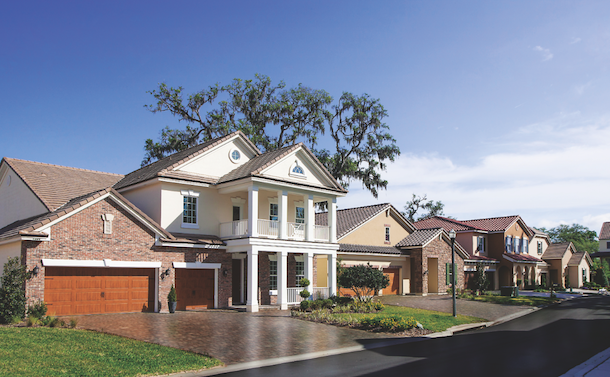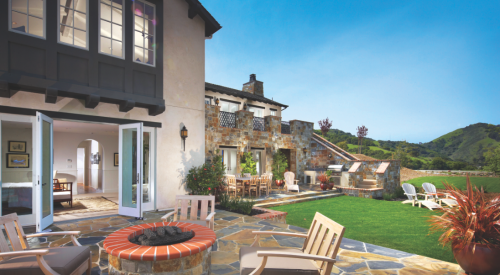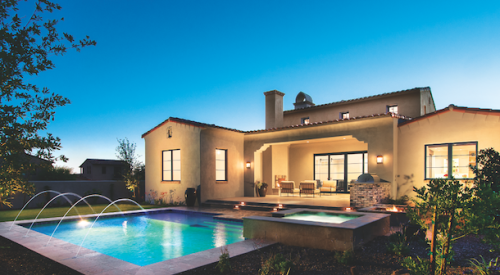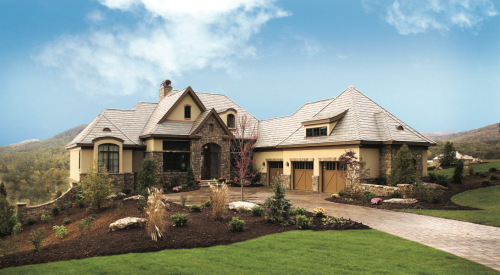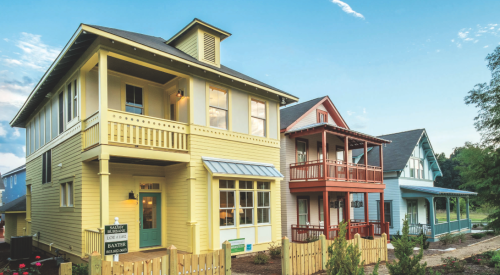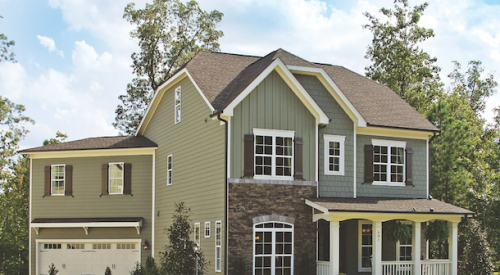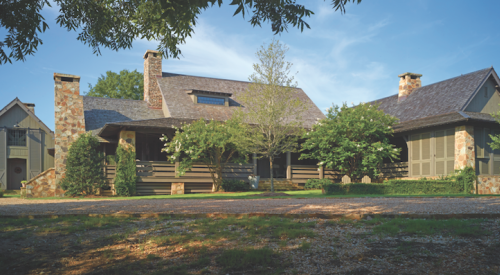While there’s plenty of eclecticism in American residential architecture today, the roots of many house styles can be traced back to the period from 1880 to 1940, when railroads expanded throughout the country.
“That’s when you really started getting these styles cross-pollinating all over the place,” says Philadelphia architect James Wentling. Styles that originated in the East, such as the Cape Cod, spread south and west and were modified to fit regional tastes. Local design review boards, and sometimes governments, imposed restrictions and requirements that also drove the evolution of those styles.
Like music and fashion, the popularity of specific architectural styles changes with the times. Craftsman, for example, has been the dominant style “for a couple of decades,” Wentling says. “In Virginia and the Carolinas, for instance, it’s really big.”
Seattle-based architect Gregory Sparhawk observes that architectural style is not necessarily regionally specific. “With modern building materials and the ability to heat houses efficiently, people have more freedom as to what design they can have,” Sparhawk says. “Of course you need to pay attention to placement and orientation, but [my clients] usually go with something that they’re comfortable with, or a style that was typical of the area where they grew up. It becomes more about the people and not as much about the place.”
Certain styles are designed for specific climate zones, says Robert Hidey, an architect based in Irvine, Calif. However, the Craftsman-style homes Hidey is currently designing for a site in Chicago aren’t much different from their Southern California counterparts. “There are subtle nuances, but for the most part it comes down to detailing,” he says.
Craftsman
Characteristics: Craftsman homes have a front porch, either full or partial width, with tapered stone columns on top of masonry piers. The windows are typically double-hung with a four-over-one or six-over-one mullion pattern in the upper sash, and are grouped together and trimmed with wide casing. Exposed rafter tails and beams or knee braces are distinctive details. Roofs are low-pitched, no steeper than 6 in 12 on a front gable roof. Roof overhangs are 18 or even 24 inches deep to accommodate brackets. Entry doors have glass panes in the upper third. There is a single dormer, often wide enough for two to three windows. The mix of exterior materials may include stone, brick, wood, concrete block, and stucco.
 Craftsman homes may have a lot of exterior ornamentation or just a little, as in this example. The roof brackets, exposed rafter tails, and tapered porch columns atop masonry piers are signature elements of the style. Photo: James Wentling
Craftsman homes may have a lot of exterior ornamentation or just a little, as in this example. The roof brackets, exposed rafter tails, and tapered porch columns atop masonry piers are signature elements of the style. Photo: James Wentling
History: The Craftsman style originated in California at the turn of the 20th century with architects Charles Sumner Greene and Henry Mather Greene, who were inspired by the English Arts and Crafts movement as well as Oriental wood architecture. Craftsman bungalows were the most popular small homes in the United States from 1905 through the 1920s.
 The Pinemore model is available in three different elevations including Craftsman (shown) at Southern Hills Plantation Club in Brooksville, Fla. This streamlined variation has the classic front porch with tapered columns and stone piers. Builder: GreenPointe Homes; Architect: BSB Design. Photo: Chris Johnson, Johnson Pictures, Inc.
The Pinemore model is available in three different elevations including Craftsman (shown) at Southern Hills Plantation Club in Brooksville, Fla. This streamlined variation has the classic front porch with tapered columns and stone piers. Builder: GreenPointe Homes; Architect: BSB Design. Photo: Chris Johnson, Johnson Pictures, Inc.
Regional variations: The piers at the base of the porch columns are traditionally made of stone, but other materials such as brick and stucco are also used. Some builders opt for less expensive manufactured stone. In another effort to cut costs, they may use roof trusses and scabbing on dimensional lumber to create the appearance of exposed rafter tails, Wentling says.
Tile roofs are often seen on California Craftsman homes, he says. “Many are built on slabs and have patios and courtyards, whereas in the Carolinas and the Mid-Atlantic states, they usually have crawl spaces and are raised above grade about 18 inches. They’re also more likely to have decks.”
Cape Cod
Characteristics: Distinguished by its low, broad profile, the Cape Cod is generally 1-1/2 stories and has a steeply pitched roof with side gables, double dormers, and a symmetrical front façade. Early versions had little exterior ornamentation other than pilasters surrounding the front door, but latter-day examples have front porches, shutters and window boxes, and front doors dressed up with sidelights. Cedar shake shingles are generally used for the roof and siding.
 Except for the attached garage, this Cape Cod is a good representation of the original style: an economically designed house that tucks extra square footage into dormers. Early Capes had stoops rather than front porches. Photo: James Wentling
Except for the attached garage, this Cape Cod is a good representation of the original style: an economically designed house that tucks extra square footage into dormers. Early Capes had stoops rather than front porches. Photo: James Wentling
History: The Cape is a cottage style that originated in colonial New England but is often associated with Levittown, where Levitt & Sons built thousands of them between 1947 and 1951.
 The Southern Cape is a regional variation of the Cape Cod. At 3,572 square feet, it’s considerably larger than the original Capes and has a full front porch and second-floor space for additional bedrooms, loft areas, and storage. Illustration: Wentling House Plans
The Southern Cape is a regional variation of the Cape Cod. At 3,572 square feet, it’s considerably larger than the original Capes and has a full front porch and second-floor space for additional bedrooms, loft areas, and storage. Illustration: Wentling House Plans
Regional variations: Capes expanded in size over the years as their popularity spread to the South, Midwest, and West. There is typically a wing on the side of the house for the garage or master suite.
“The Cape is the most efficient way to utilize square footage with a minimal exterior envelope,” Wentling says. “You just tuck the upstairs rooms in dormers under the roof.”
Farmhouse
Characteristics: The farmhouse is a hybrid of various architectural styles, some of which came from the Old World and others that were introduced by early settlers on the East Coast. Farmhouses feature slender, vertical main forms; steeply pitched roofs with open gables; vertically proportioned doors and windows; long, deep porches; and linear, T-shaped, or L-shaped floor plans.
 Here’s a modern take on farmhouse style. The stone accents, covered porch, and dormer windows hark back to traditional farmhouses, with more contemporary touches such as the board-and-batten siding and attached, front-loaded garage. Builder: Sean Ruppert, OPal; Architect: Gregory Sparhawk, GPS Designs Architecture. Photo: Bob Narod
Here’s a modern take on farmhouse style. The stone accents, covered porch, and dormer windows hark back to traditional farmhouses, with more contemporary touches such as the board-and-batten siding and attached, front-loaded garage. Builder: Sean Ruppert, OPal; Architect: Gregory Sparhawk, GPS Designs Architecture. Photo: Bob Narod
History: The earliest farmhouses were built by colonial families of the 1700s and are associated with starkly simple Folk architecture. They were one-story, 1-1/2 story, or two-story homes and sometimes a mix of forms, often starting out modest in size and growing along with the family. Formal spaces were located at the front of the house and informal areas at the back. Farmhouses were painted white, with color provided by a stone base, a stone or brick chimney, and dark-painted doors.
Regional variations: As building materials became more accessible with the expansion of railroads, wealthy landowners adopted styles that were popular at the time. Classic forms and details from Greek Revival, Georgian, and Victorian architecture were incorporated. An early 1900s farmhouse with a long wraparound porch and Queen Anne posts and railings is referred to as a Queen Anne farmhouse, while one with Greek columns popular in the mid-1800s might be known as a Greek Revival farmhouse.
Home buyers gravitate to farmhouse style because it’s easily recognizable, says Sparhawk: “It goes back to simpler forms—gable roofs that aren’t overly complicated. It’s trimmed down and a little cleaner.”
Traditional clapboard or board-and-batten siding, metal roofing, and porches are identifiable farmhouse elements. A more recent trend is the Modern farmhouse, where the key features are open floor plans, high ceilings, and lots of glass.
Coastal
Characteristics: Coastal homes can take on many forms, from tropical cottage to New England Saltbox to shingle-style home and Mediterranean villa. The side oriented to ocean views has large windows, decks, and porches, plus doors that slide open to capture breezes. The roof forms vary from steeply pitched gables to gambrels. Deep roof overhangs shield the home from the elements. Coastal homes typically have metal roofs to stand up to harsh weather.
 Coastal design can take many forms from New England cottages to rambling shingle-style homes, but all coastal homes have windows, porches, and decks that capture views and breezes. Builder: Joseph Downey, Olde Pointe Builders; Architect: Gregory Sparhawk, GPS Designs Architecture. Photo: Bob Narod
Coastal design can take many forms from New England cottages to rambling shingle-style homes, but all coastal homes have windows, porches, and decks that capture views and breezes. Builder: Joseph Downey, Olde Pointe Builders; Architect: Gregory Sparhawk, GPS Designs Architecture. Photo: Bob Narod
History: The first coastal cottages were built in colonial New England, but over the years there’s been a lot of stylistic variation, depending on geography. For example, between 1900 and 1930 when Florida experienced significant growth, Art Deco was the predominant style with its streamlined designs, flamboyant colors, and sculptural elements celebrating the tropical ambience. In Southern California, coastal homes featured muted colors and wide-open designs inspired by nature. Mid-century modern homes proliferated because their broad windows embraced ocean views and their deep eaves and trellises provided shade from year-round sunlight.
 At Old San Jose on the River in Jacksonville, Fla., single-family homes incorporate styles from the surrounding neighborhood as well as new styles to give the community a fresh feel. Shown, from left, are Georgian, Tuscan, Mediterranean, and French Country styles. Builder: New Leaf Construction; Architect: BSB Design. Photo: Jacob Sharp
At Old San Jose on the River in Jacksonville, Fla., single-family homes incorporate styles from the surrounding neighborhood as well as new styles to give the community a fresh feel. Shown, from left, are Georgian, Tuscan, Mediterranean, and French Country styles. Builder: New Leaf Construction; Architect: BSB Design. Photo: Jacob Sharp
Regional variations: Tidewater houses, with their large wraparound porches and hip roofs, are most common in the Southeast. They have crawl spaces that allow for air circulation and protect from flooding, and may also be elevated on piers. Awning windows are often used because they can be propped open to capture breezes while keeping out rain and salt spray. In contrast, coastal residences in New England and Long Island, N.Y., often have gambrel roofs, eyebrow dormers, and long-lasting cedar shingles that weather to a soft gray over time.
Coastal homes don’t necessarily have to be located near a body of water, Sparhawk says. “A large shingle-style home won’t appear out of place as long as it’s got some room to breathe and a bit of presence on the site,” he says.
Wilder Pays Homage to Local Architecture
Orinda, Calif., is a San Francisco suburb much sought after for its schools, small-town charm, and rural landscapes. To allay the town’s concerns about a new community called Wilder, Robert Hidey Architects developed five house styles based on California vernacular architecture: Classic Orinda Ranch, East Bay Arts & Crafts, Spanish Colonial Revival, Bay Area Cottage, and Adobe Ranch.
“We evaluated Orinda’s existing housing stock, which was built between the 1950s and the 1970s, found predominant styles, and developed guidelines for those specific styles,” says Hidey.
 The Classic Orinda Ranch is an interpretation of the older ranch homes of Orinda, Calif., a San Francisco suburb. The home features a stone-wrapped entry portico leading through a rustic wooden gate to a covered loggia and entry foyer. Photos: Toby Ponnay Photography
The Classic Orinda Ranch is an interpretation of the older ranch homes of Orinda, Calif., a San Francisco suburb. The home features a stone-wrapped entry portico leading through a rustic wooden gate to a covered loggia and entry foyer. Photos: Toby Ponnay Photography
 The great room has vaulted ceilings and French doors that access a stone deck and a loggia with a fireplace.
The great room has vaulted ceilings and French doors that access a stone deck and a loggia with a fireplace.
The Classic Orinda Ranch is a two-story, 5,414-square-foot plan with multiple wings, roof treatments, and building materials. Large windows capture views of the natural surroundings. “The scale of the house is significantly larger than was typically built in Orinda,” he says. “But we were able to hold onto a one-story expression on the street frontage. A lot of the square footage comes from the walkout lower level in the rear.”
Hidey designed 18 different floor plans that accommodate the hilly terrain. The developer, Brooks Street, is working with various builders including Shapell Homes.
When completed, Wilder will consist of 245 homes on 1,600 acres, most of which will be left undeveloped with an extensive trail system. Brooks Street reported more than 40 sales as of January 2014. The semi-custom and custom homes will be built on lots averaging 1/2 acre, and range in price from $1.5 to $3 million-plus.









